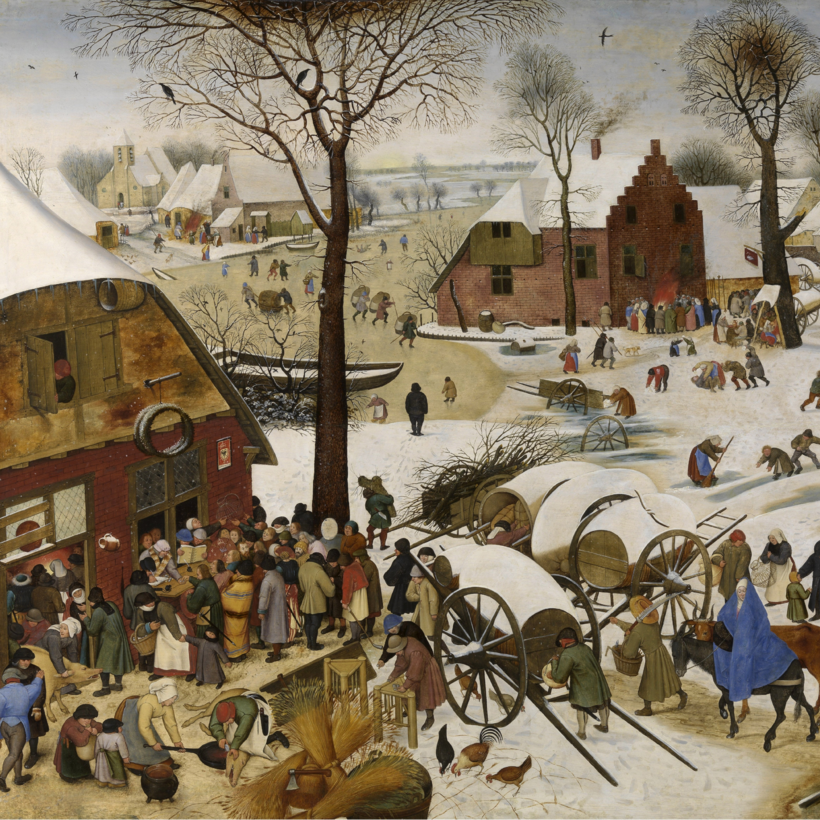In Europe, the period from the 16th to the 19th century was especially cold. In winter, canals in Holland regularly froze and Baltic ports were blocked with ice. This is commonly known as the Little Ice Age, and several causes have been proposed including low solar radiation. The sociocultural effects seem clear. The Dutch developed a talent for speed skating, which they retain to this day. Artists displayed a fondness for clouds and dark storms. Beer grew in popularity when vineyards failed. Persecution of women for witchcraft peaked since societies always seek someone to blame.
Then again, the line from cause to effect might simply be a figment of scholarly imagination. It’s fun to connect the dots, but not always sensible to do so. As Peter Frankopan, a professor of global history at Oxford, writes, “Identifying what effect cooler temperatures have on trends, fashions and even individual events … requires careful judgment.” Be careful about confusing coincidence with causation.
Frankopan is nevertheless interested in connections — how environmental events shape human activity and vice versa. Often, the line from cause to effect is undeniable. The eruption of Mount Tambora on the island of Sumbawa in modern-day Indonesia in 1815, for instance, undoubtedly caused crop failures in Europe, with the poor suffering as they always do.
The arrow of impact can, however, also point the opposite way — from Man to the environment. In 1603, James I ordered 20 beaver hats, thus inspiring a popular fad. It was not a good time to be a beaver. The European beaver population was promptly wiped out and new sources elsewhere were ruthlessly exploited. Since beavers are industrious landscape architects, the environmental effect of those hats was profound. Dams went into disrepair, ponds disappeared and a delicate balance was forever altered.
Human beings were once virtually helpless in the face of storms, solar phases, volcanic eruptions, earthquakes and pathogens. The Bible story about Sodom and Gomorrah, when “burning sulphur” rained from the heavens, could relate to an actual meteor strike that destroyed the city of Tell el-Hammam around 1650 BC. Nowadays, however, the tables have turned: Man is the destructive force and Earth his victim. “We seem to have arrived at the edge of a precipice,” Frankopan writes. He uses the past “to understand how our species has transformed the Earth to the point that we now face such a perilous future”.
According to Frankopan, historians have habitually ignored the environment. “Most people can name the great leaders and major battles in the past, but few can name the biggest storms, the most significant floods, the worst winters, the most severe droughts.” Addressing that deficiency, he has produced a history of the world that integrates natural history into the human story. This, he boasts, is “an untold history”. That’s not strictly true since his book relies heavily on secondary sources. This story has been told before, but predominantly in dry, inaccessible monographs. Frankopan has brought all this scholarly work together into a massive book that is comprehensive, well-informed and fascinating. It has the intellectual weight and dramatic force of a tsunami.
The Dutch developed a talent for speed skating, which they retain to this day. Beer grew in popularity when vineyards failed.
The first part of the book is a gripping story of how the Earth shaped human experience. Storms, eruptions, earthquakes and disease are the main characters in this drama. Oh, and locusts. Sudden hormonal changes alter body and wing size, which in turn causes them to swarm, sometimes in their billions. In natural disasters of this sort, religion provided explanation, reassurance and sometimes solution. Witness, for instance, when Pope Pius V dealt with a locust swarm in the 16th century by excommunicating the insects. According to papal records, “they soon disappeared, never to be seen again”.
Granted, the effects of environmental anomalies were not always negative. There were winners and losers in every crisis. Genghis Khan benefited from the weather in Mongolia during his heyday being the wettest for 1,100 years. This increased the carrying capacity of the steppes — lots of lush pasture for his horses — while weakening his opponents whose sedentary lifestyle depended on drier conditions.
Brief cataclysms have had big long-term consequences. Experts speculate that gases and acids ejected with the eruption on Thera/Santorini around 1600BC might have created the perfect primordial soup for the emergence of the smallpox virus, which would eventually kill half a billion people in the 19th and 20th centuries. Elsewhere, global cooling about 150 million years ago caused the seas to recede, leaving behind huge deposits of plankton in what is now the southeastern United States. That made the soil highly fertile — perfect for cotton, tobacco and slave labor. Those ancient plankton deposits still correlate closely with voting patterns in the US.
Finally, it’s difficult to imagine Brexit ever becoming an issue if not for a huge landslip on the Norwegian coast that occurred around 6150 BC. It caused a tsunami to sweep through the Channel, destroying Doggerland, the land bridge that connected Britain to the European continent. An island mentality was born.
Storms, eruptions, earthquakes and disease are the main characters in this drama.
When Frankopan reaches the 18th century, his focus shifts — Man, once a helpless victim, becomes instead the pillager of his environment. Forests were cleared to make way for cash crops. Mines scarred the landscape and poisoned the aquifer. The burning of coal, then oil, released carbon dioxide into the atmosphere. Despoliation was driven by rapacious greed. “Demand for goods”, Frankopan writes, “came with … environmental prices that were charged to the parts of the world they originated from … usually unpaid by those living … thousands of kilometers away.”
Human arrogance was often breathtaking. “When we ask the mountain to bow its head it has to do so!” Mao Zedong proclaimed. “When we ask the river to yield the way, it must yield!” In 1958, obsessed with the idea that sparrows were eating Chinese grain crops, Mao instructed his people to destroy sparrow nests and kill the birds. They responded enthusiastically, with two billion sparrows perishing across China. The government then discovered that, although the little birds did indeed eat grain, they more importantly ate the insects that consumed grain. The result, according to one historian, was “the greatest human-created famine in history”. It would be easy to dismiss this madness as typical of Communist zealotry, but capitalists have not been conspicuously wiser custodians of nature.
This is an endlessly fascinating book, an easy read on an important issue. Frankopan writes with confidence about complex scientific topics such as the Atlantic Meridional Overturning Circulation and the analysis of tree rings. His authority, however, makes the result depressing since this story is inevitably about humans accelerating toward their destruction. More than half of the carbon-based fuel burned over the course of human history has taken place since 1990. China used more concrete from 2011 to 2013 than the US did during the entire 20th century. Air-conditioning has allowed cities to expand in places otherwise inhospitable. In Saudi Arabia, for instance, “700,000 barrels of oil a day are burned, primarily to keep premises cooler than they would otherwise be”. As rooms cool, the Earth warms.
On Earth Day 1970, Walt Kelley’s cartoon character Pogo proclaimed: “We have met the enemy and he is us.” Frankopan is not optimistic that wisdom will prevail and a harmonious balance between Man and Nature will be found. As he rightly points out, the Earth will eventually win. It will correct itself, bringing carbon into a sustainable balance through catastrophic depopulation — famine, disease or war. Or it will revert to what it once was: a hot, poisonous place where humans can’t possibly live. The result of this transformation matters not to the Earth. It matters only to us.

Gerard DeGroot is a professor of modern history at the University of St. Andrews and the author of several books, including The Bomb: A Life and The Seventies Unplugged


